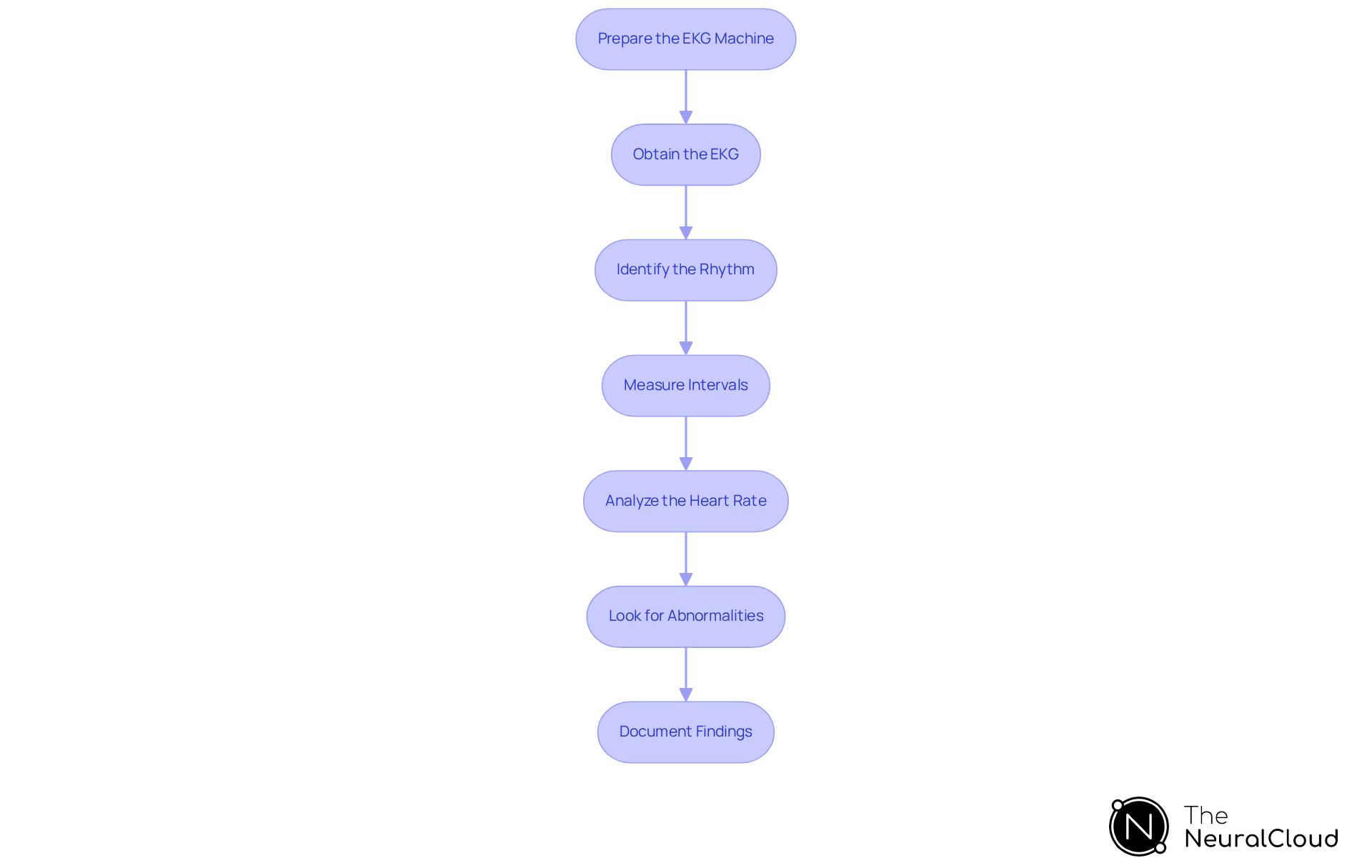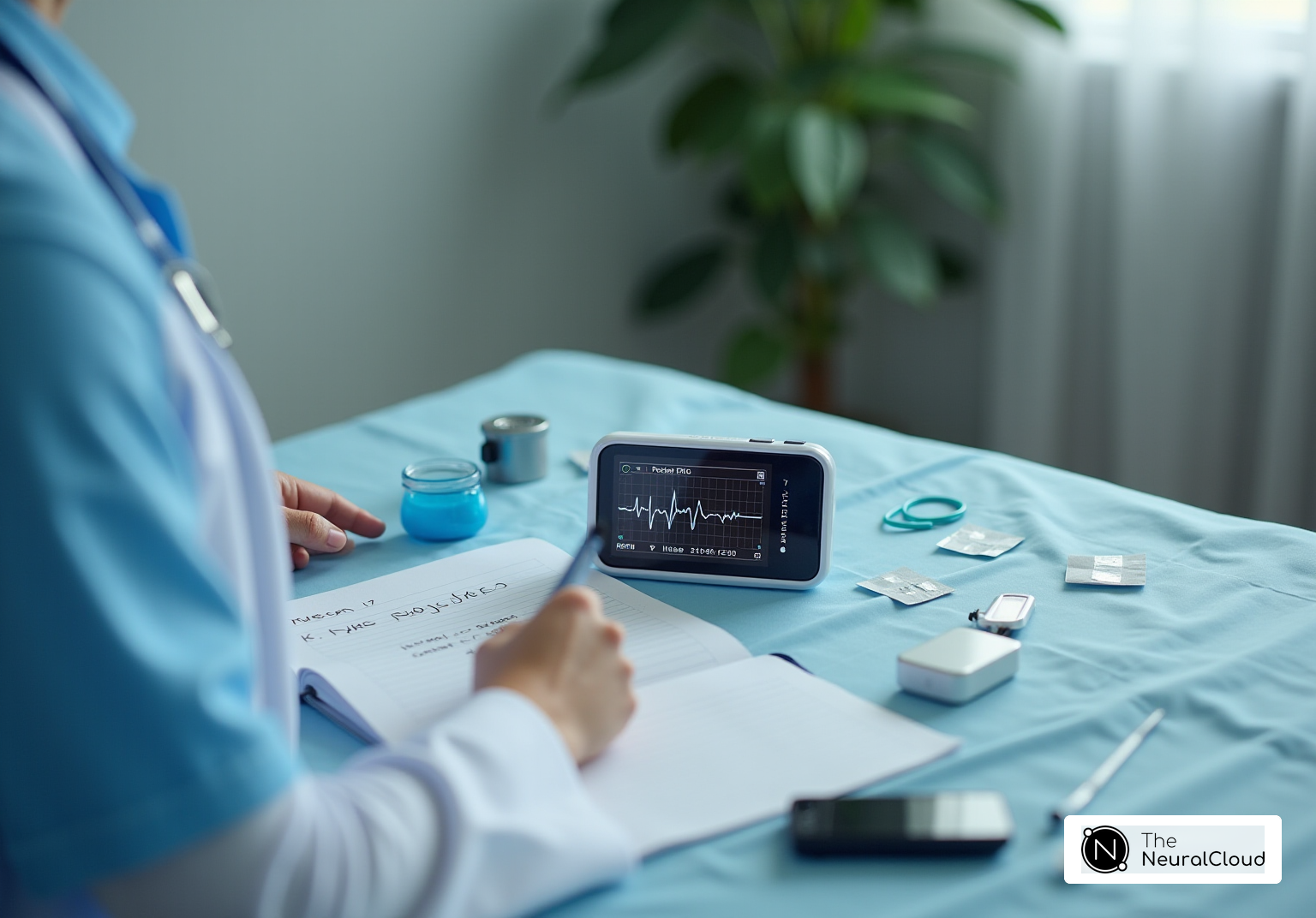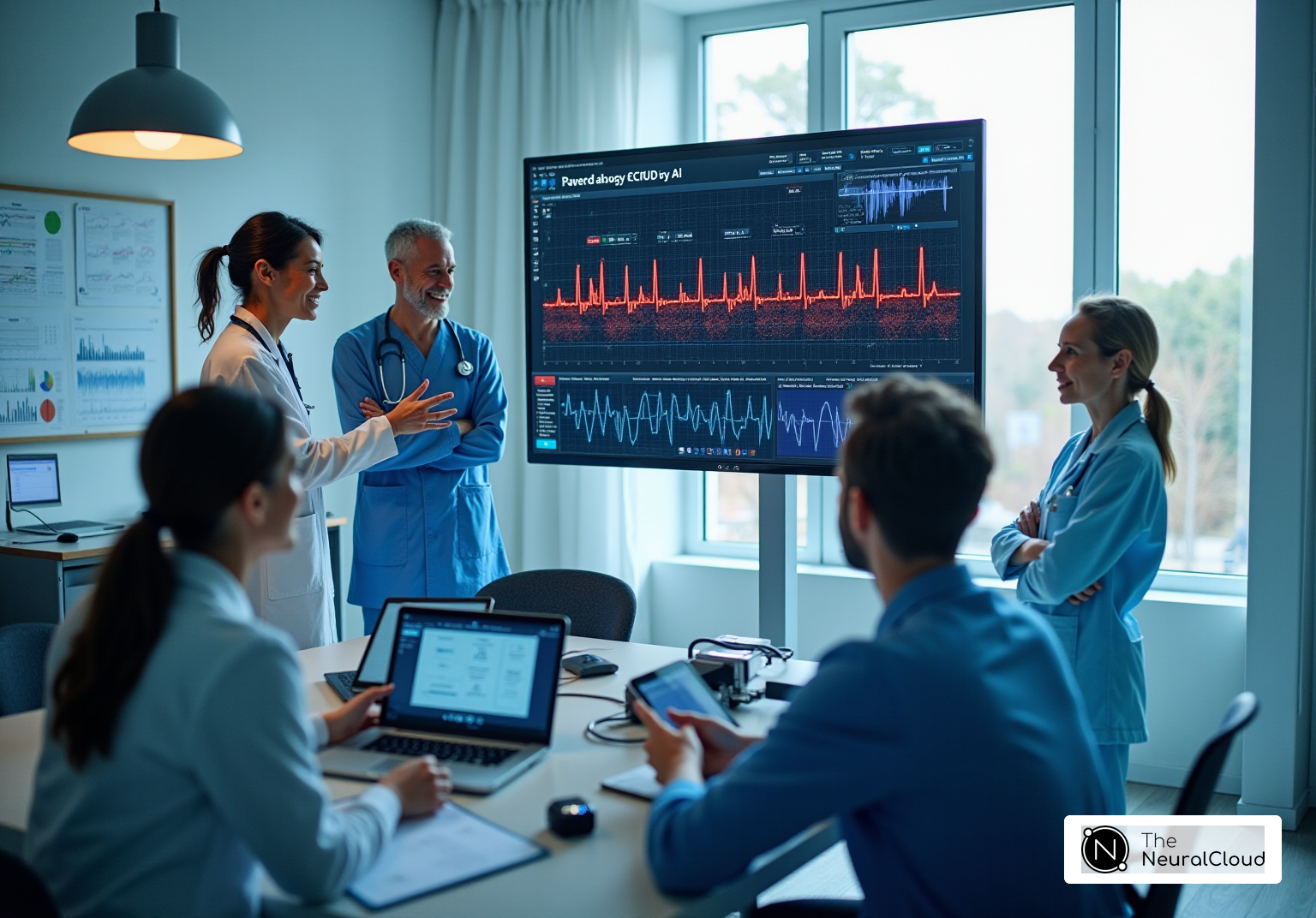Overview
This article serves as a comprehensive step-by-step guide for health tech developers aiming to master EKG reading. It emphasizes the importance of understanding the basic components of an electrocardiogram and the process for accurate interpretation.
In the realm of ECG analysis, professionals often face challenges such as misinterpretation and inefficiencies. The MaxYield™ platform addresses these issues by offering a suite of features designed to enhance the accuracy and efficiency of EKG analysis.
Features of MaxYield™:
- Streamlined interface for easy navigation
- Advanced algorithms for precise interpretation
- Real-time data analysis capabilities
These features provide significant advantages, including reduced error rates and faster decision-making processes. By utilizing MaxYield™, healthcare professionals can improve their diagnostic capabilities, ultimately leading to better patient outcomes.
In conclusion, the MaxYield™ platform not only simplifies the EKG reading process but also empowers healthcare providers with the tools they need to deliver high-quality care. Its benefits extend beyond mere efficiency, fostering a deeper understanding of ECG data and enhancing overall clinical practice.
Introduction
Mastering the art of EKG reading is crucial for health tech developers focused on improving cardiac care. The complexities of electrocardiograms can often lead to misinterpretations and diagnostic challenges. This guide aims to clarify these intricate components while introducing innovative solutions like MaxYield™, which streamline the interpretation process. How can healthcare professionals effectively navigate these hurdles to ensure accurate readings and enhance patient outcomes?
The MaxYield™ platform addresses the challenges in ECG analysis by offering a range of features designed to simplify the reading process. It provides intuitive tools that enhance the accuracy of EKG interpretations, reducing the likelihood of errors. By leveraging advanced algorithms, MaxYield™ not only speeds up the analysis but also ensures that healthcare professionals can make informed decisions quickly.
The advantages of using MaxYield™ are significant. Healthcare professionals benefit from improved diagnostic accuracy, which directly translates to better patient outcomes. With its user-friendly interface, MaxYield™ allows both seasoned experts and those new to EKG reading to navigate complex data with ease. This accessibility fosters a more efficient workflow, ultimately enhancing the quality of cardiac care.
Understand the Basics of EKGs
To master EKG reading, it's crucial to start with learning how to read the basic components of an electrocardiogram. An EKG measures the electrical activity of the heart, represented as a series of waves on a graph. Key elements include:
- P Wave: Represents atrial depolarization.
- QRS Complex: Indicates ventricular depolarization and is the most prominent feature of the EKG.
- T Wave: Reflects ventricular repolarization.
Grasping these elements is essential for learning how to read EKG, as they provide insights into the heart's rhythm and function. Additionally, familiarize yourself with the standard 12-lead EKG configuration, which captures various perspectives of the heart's electrical activity, enabling thorough analysis.
However, learning how to read EKG can be challenging due to the complexity of data interpretation. This is where MaxYield™ comes into play.
Features of MaxYield™:
- Automated EKG interpretation
- Accurate readings
- Scalable solutions for diverse clinical settings
Advantages for Healthcare Professionals:
- Enhances efficiency in EKG analysis
- Adapts to various clinical environments
- Improves diagnostic accuracy
With the integration of MaxYield™, healthcare professionals can leverage these automated, accurate, and scalable solutions to enhance their EKG interpretation. This not only streamlines the process but also makes it more adaptable to the demands of different clinical settings.

Follow a Step-by-Step Process to Read EKGs
To effectively read an EKG, follow these steps:
-
Prepare the EKG Machine: Ensure the machine is calibrated and electrodes are properly placed on the patient’s skin to minimize noise and artifacts. This preparation is crucial for learning EKG how to read accurate readings.
-
Obtain the EKG: Record the EKG for at least 10 seconds to capture a representative sample of the cardiac activity. A longer recording helps in identifying any irregularities in heart function.
-
Identify the Rhythm: Examine the P waves, QRS complexes, and T signals to determine the heart rhythm. Check for regularity and the existence of each signal, as this will provide insights into the heart's electrical activity.
-
Measure Intervals: Calculate the PR interval (from the start of the P wave to the start of the QRS complex), QRS duration, and QT interval (from the start of the QRS complex to the end of the T wave). These measurements assist in evaluating the organ's electrical conduction and are essential for understanding EKG how to read, which can indicate potential issues.
-
Analyze the Heart Rate: Use the EKG paper to calculate the heart rate. Count the number of QRS complexes in a 6-second strip and multiply by 10 for beats per minute. This calculation is essential for assessing the heart's performance and understanding EKG how to read.
-
Look for Abnormalities: Identify any deviations from normal patterns, such as ST segment elevation or depression, which may indicate ischemia or other cardiac conditions. Recognizing these abnormalities is vital for timely intervention.
-
Document Findings: Record your observations and interpretations, noting any abnormalities for further review by a healthcare professional. Proper documentation ensures that critical information is communicated effectively.

Troubleshoot Common EKG Reading Issues
When it comes to EKG how to read, several common issues may arise. Here’s how to troubleshoot them effectively:
-
Poor Signal Quality: Noisy or unclear EKG traces often stem from improper electrode placement or inadequate skin preparation. Ensure electrodes are securely attached and that the skin is clean and dry. Studies indicate that correct electrode positioning and skin preparation can reduce irregularities by up to 70%, significantly enhancing signal clarity. Additionally, the MaxYield™ platform from Neural Cloud Solutions helps identify and label critical data even in recordings with high levels of noise, improving the overall diagnostic yield. It also salvages previously obscured sections of lengthy Holter, 1-Lead, and patch monitor recordings, ensuring that no critical information is lost.
-
Artifact Interference: Movement or electromagnetic interference can distort EKG readings. To minimize these artifacts, reduce patient movement during recordings and ensure that the equipment is free from external electrical sources. Notably, motion disturbances can lead to a misdiagnosis rate of up to 45% in automated ECG systems. MaxYield™ tackles these challenges by swiftly isolating ECG signals from recordings impacted by baseline wander and muscle artifact, highlighting the necessity for vigilance in these areas.
-
Misinterpretation of Waves: If wave identification is challenging, revisit the fundamentals of EKG components. Regular practice with sample EKGs can improve your skills in EKG how to read. Misinterpretation of artifacts can lead to a misdiagnosis rate of 14.3% among residents, while automated systems can experience similar rates due to motion disturbances. Understanding EKG how to read includes identifying artifacts—such as by finding an unaffected lead or mapping out unaffected R-R intervals—which is crucial for accurate interpretation. The MaxYield™ platform enhances this process by evolving its algorithms with each use, thereby improving accuracy over time.
-
Inconsistent Heart Rate: An irregular heart rate may indicate arrhythmias. Use a longer EKG strip to confirm the rhythm and consult with a cardiologist if necessary. Understanding how to read EKG is crucial, as artifacts can mimic serious conditions.
-
Documentation Errors: Always double-check your notes against the EKG printout to ensure accuracy in your findings. Mislabeling can have significant clinical implications, making meticulous documentation essential for patient safety.

Conclusion
Mastering EKG reading is a crucial skill for healthcare professionals, enabling them to accurately interpret the heart's electrical activity. Understanding the fundamental components of EKGs—such as the P wave, QRS complex, and T wave—provides practitioners with a solid foundation for advanced analysis. Innovative tools like MaxYield™ enhance this process by offering automated interpretations that streamline workflow and improve diagnostic accuracy.
The article presents a systematic approach to reading EKGs, highlighting the importance of:
- Preparation
- Rhythm identification
- Interval measurement
- Documentation
Key troubleshooting tips address common issues, including:
- Poor signal quality
- Misinterpretation of waveforms
This ensures healthcare providers can effectively navigate challenges. With these insights, professionals can significantly reduce the risk of misdiagnosis and enhance patient care.
Ultimately, mastering EKG reading transcends technical skills; it involves leveraging technology like MaxYield™ to improve outcomes and adapt to diverse clinical environments. By committing to continuous learning and remaining vigilant against common pitfalls, healthcare professionals can elevate their practice and contribute meaningfully to the critical field of cardiac care.
Frequently Asked Questions
What is an EKG and what does it measure?
An EKG, or electrocardiogram, measures the electrical activity of the heart, represented as a series of waves on a graph.
What are the key components of an EKG?
The key components of an EKG include the P Wave (represents atrial depolarization), the QRS Complex (indicates ventricular depolarization and is the most prominent feature), and the T Wave (reflects ventricular repolarization).
Why is it important to understand the basic components of an EKG?
Understanding the basic components of an EKG is essential for interpreting the heart's rhythm and function, which is crucial for accurate diagnosis and treatment.
What is the standard 12-lead EKG configuration?
The standard 12-lead EKG configuration captures various perspectives of the heart's electrical activity, allowing for a thorough analysis.
What challenges do individuals face when learning to read EKGs?
Learning to read EKGs can be challenging due to the complexity of data interpretation involved.
What is MaxYield™ and how does it assist in EKG interpretation?
MaxYield™ is a tool that offers automated EKG interpretation, providing accurate readings and scalable solutions for diverse clinical settings.
What are the advantages of using MaxYield™ for healthcare professionals?
The advantages of using MaxYield™ include enhanced efficiency in EKG analysis, adaptability to various clinical environments, and improved diagnostic accuracy.
How does MaxYield™ impact the EKG interpretation process?
The integration of MaxYield™ streamlines the EKG interpretation process, making it more adaptable to the demands of different clinical settings.






